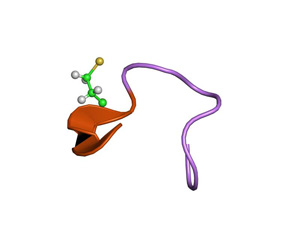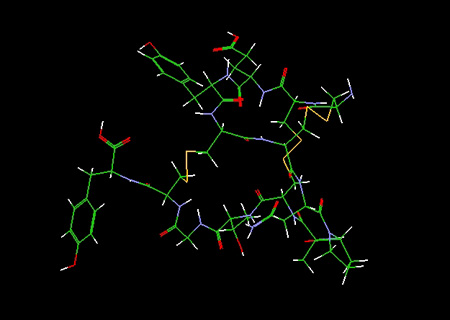Linzess --
Linaclotide is a synthetic, fourteen amino acid peptide and agonist of intestinal guanylate cyclase type C (GC-C), which is structurally related to the guanylin peptide family, with secretagogue, analgesic and laxative activities. Upon oral administration, linaclotide binds to and activates GC-C receptors located on the luminal surface of the intestinal epithelium. This increases the concentration of intracellular cyclic guanosine monophosphate (cGMP), which is derived from guanosine triphosphate (GTP). cGMP activates the cystic fibrosis transmembrane conductance regulator (CFTR) and stimulates the secretion of chloride and bicarbonate into the intestinal lumen. This promotes sodium excretion into the lumen and results in increased intestinal fluid secretion. This ultimately accelerates GI transit of intestinal contents, improves bowel movement and relieves constipation. Increased extracellular cGMP levels may also exert an antinociceptive effect, through an as of yet not fully elucidated mechanism, that may involve modulation of nociceptors found on colonic afferent pain fibers. Linaclotide is minimally absorbed from the GI tract.
Structure
Linaclotide is a peptide consisting of 14 amino acids. The sequence is
H–Cys1–Cys2–Glu3–Tyr4–Cys5–Cys6–Asn7–Pro8–Ala9–Cys10–Thr11–Gly12–Cys13–Tyr14–OH
There are three disulfide bonds: Between Cys1 and Cys6, between Cys2 and Cys10, and between Cys5 and Cys13.

How does Linzess Work?
LINZESS is thought to work in two ways based on nonclinical studies. LINZESS binds to the GC-C receptor locally, within the intestinal epithelium. Activation of GC-C results in increased intestinal fluid secretion and transit and a reduction in visceral pain, which is thought to be mediated by decreased activity of pain-sensing nerves. The clinical relevance of the effect on pain fibers in nonclinical studies has not been established.
What is the GC-C Receptor that linzess is thought to bind to?
Guanylate cyclase 2C, also known as guanylyl cyclase C (GC-C), intestinal guanylate cyclase, guanylate cyclase-C receptor, or the heat-stable enterotoxin receptor (hSTAR) is an enzyme that in humans is encoded by the GUCY2C gene.
GC-C is a key receptor for heat-stable enterotoxins that are responsible for acute secretory diarrhea. Heat-stable enterotoxins are produced by pathogens such as Escherichia coli. Knockout mice deficient in the GC-C gene do not show secretory diarrhea on infection with E. coli, though they do with cholera toxin. This demonstrates the specificity of the GC-C receptor.
About E-coli heat stabile enterotoxin
The mature heat stable protein from Escherichia coli, which is the cause of acute diarrhoea in infants and travellers in developing countries, is a 19-residue peptide containing three disulphide bridges that are functionally important.

Linzess and Possible Inhibition of Colon Cancer
..."In recent years there is significant evidence to support the hypothesis that guanylyl cyclase C (GUCY2C) is a tumor suppressor in the intestine, and that the loss of hormone ligands for this receptor is an important step in the disease process. Thus, ligand replacement therapy has been proposed as a strategy to prevent colorectal cancer. Until recently this strategy was not clinically plausible; however, the recent regulatory approval of Linaclotide (LINZESS™, Forest Laboratories and Ironwood Pharmaceuticals, Inc.), an oral GUCY2C ligand, has raised the possibility of utilizing this strategy clinically to prevent colorectal cancer...Observations reveal GUCY2C as a key mediator of intestinal tumor susceptibility and highlight GUCY2C ligands as promising preventative agents against CRC..." --see Reference 2
References
1--Cure and Curse: E. coli Heat-Stable Enterotoxin and Its Receptor Guanylyl Cyclase C
2--Translating Colorectal Cancer Prevention through the Guanylyl Cyclase C Signaling Axis
3- Linaclotide Acetate in Preventing Colorectal Cancer in Healthy Volunteers-- Phase I Trial

